Cocoa, the key ingredient in chocolate, is renowned for its rich flavor and indulgent qualities. However, beyond its culinary applications, cocoa also possesses impressive antioxidant properties that contribute to its many health benefits. This article will explore the antioxidant qualities of cocoa, how they work, and the potential health implications of incorporating cocoa into one’s diet.
Key Takeaways
- Cocoa is a rich source of antioxidant compounds, particularly flavanols.
- Antioxidants in cocoa help neutralize free radicals and reduce oxidative stress.
- The antioxidant properties of cocoa may contribute to various health benefits, including cardiovascular and cognitive function.
- Factors such as processing methods and cocoa variety can influence the antioxidant content of cocoa.
- Consuming cocoa, particularly in the form of dark chocolate, can be part of a healthy, balanced diet when done in moderation.
Introduction to Cocoa and Antioxidants
Cocoa, the key ingredient in chocolate, is derived from the dried and fermented seeds of the Theobroma cacao tree. This versatile ingredient can be found in various forms, including cocoa powder and cocoa nibs, which are widely used in many food and beverage products. Interestingly, the unique composition of cocoa, particularly its high concentration of polyphenolic compounds, is what gives it its distinctive flavor and impressive antioxidant properties.
What is Cocoa?
Cocoa is the primary ingredient in chocolate and is extracted from the seeds, or beans, of the Theobroma cacao tree. This tropical tree is native to Central and South America and has been cultivated for centuries for its flavorful and nutritious seeds. The types of cocoa used in various products can include cocoa powder, cocoa nibs, and cocoa liquor, each offering unique characteristics and applications.
The Importance of Antioxidants
Antioxidants play a crucial role in human health by neutralizing harmful free radicals and reactive oxygen species that can contribute to oxidative stress and the development of various health conditions. The importance of antioxidants in the diet has been well-documented, and the antioxidant properties of cocoa have been a subject of extensive research, highlighting the potential health benefits of incorporating this ingredient into a balanced diet.
Flavanols: The Powerhouse Antioxidants in Cocoa
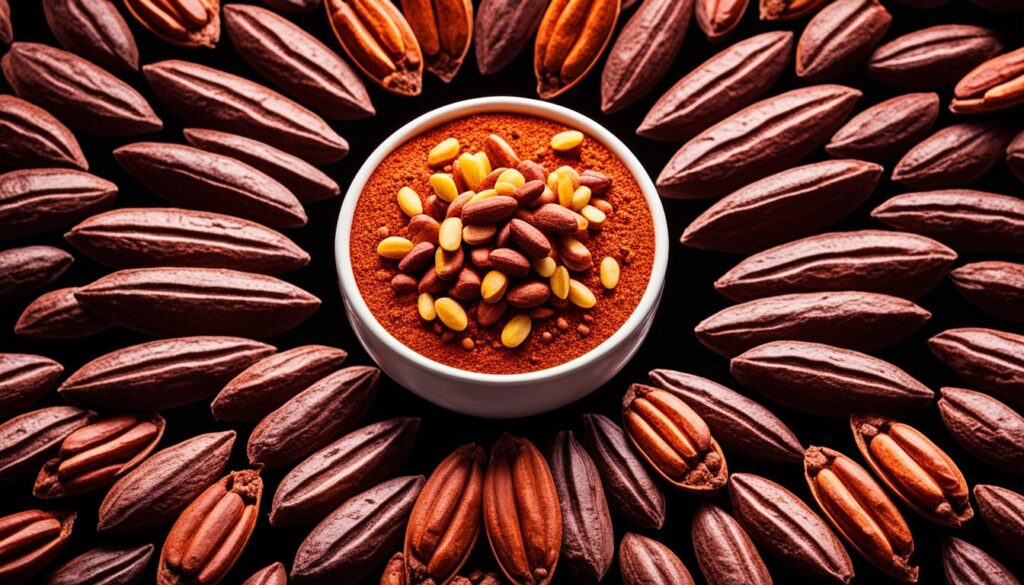
The antioxidant properties of cocoa are primarily attributed to its high concentration of flavanols, a subclass of flavonoids. Cocoa contains several types of flavanols, including catechins, epicatechins, and procyanidins, all of which possess potent antioxidant and anti-inflammatory properties.
Types of Flavanols in Cocoa
Cocoa is a rich source of various cocoa flavanols, including:
- Catechins: These are the most abundant flavanols in cocoa and are known for their strong antioxidant activity.
- Epicatechins: These are the most bioavailable and easily absorbed flavanols in cocoa, making them particularly beneficial for health.
- Procyanidins: These complex flavanol molecules also contribute to the potent antioxidant and anti-inflammatory properties of cocoa.
Health Benefits of Flavanols
The health benefits of cocoa flavanols are widespread and well-documented. These antioxidant properties of cocoa flavanols have been associated with:
- Improved cardiovascular health by reducing inflammation and oxidative stress
- Enhanced cognitive function and neuroprotection
- Reduced risk of type 2 diabetes and improved insulin sensitivity
- Anti-cancer properties by inhibiting tumor growth and metastasis
- Improved skin health and protection against UV damage
The potent antioxidant properties of cocoa flavanols make them a valuable component of a healthy, balanced diet.
What are the antioxidant properties of cocoa?

Cocoa’s impressive antioxidant properties are primarily attributed to its high concentration of polyphenolic compounds, particularly the flavanols. These potent compounds possess the ability to neutralize free radicals and reactive oxygen species, which are strongly associated with oxidative stress and the development of various health conditions.
Antioxidant Activity Measurement
The antioxidant activity of cocoa has been extensively studied using various analytical techniques, such as the Oxygen Radical Absorbance Capacity (ORAC) assay and the Trolox Equivalent Antioxidant Capacity (TEAC) assay. These methods quantify the antioxidant capacity of cocoa, providing insights into its potent free radical scavenging abilities.
Cocoa’s High Antioxidant Capacity
Numerous studies have demonstrated that cocoa exhibits a remarkably high antioxidant capacity compared to many other food sources, including green tea, red wine, and various fruits and vegetables. This exceptional antioxidant property of cocoa is attributed to its unique phytochemical composition, particularly the abundance of flavanol compounds.
| Antioxidant Assay | Cocoa ORAC Value | Comparison to Other Foods |
|---|---|---|
| Oxygen Radical Absorbance Capacity (ORAC) | 26,000 – 107,000 μmol TE/100g | Significantly higher than green tea, red wine, and many fruits and vegetables |
| Trolox Equivalent Antioxidant Capacity (TEAC) | 3.2 – 7.8 mmol TE/100g | Comparable to or higher than various berries and other antioxidant-rich foods |
Factors Affecting Cocoa’s Antioxidant Content
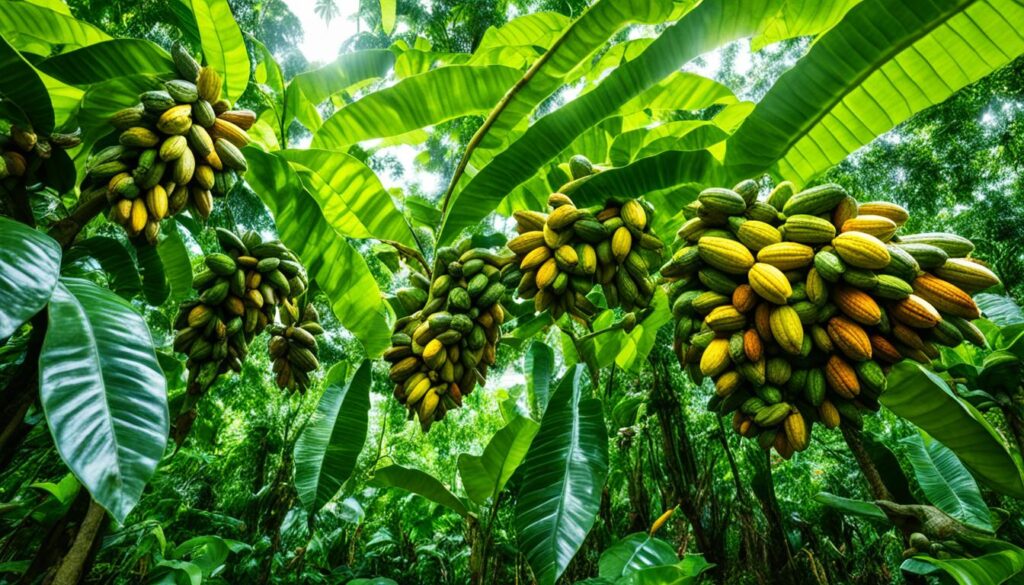
The antioxidant content and properties of cocoa can be influenced by various [factors affecting cocoa’s antioxidant content], including the [impact of processing on cocoa antioxidants] used and the [influence of cocoa variety and origin on antioxidants].
Processing Methods
The way cocoa beans are processed can have a significant impact on their antioxidant content. Factors such as fermentation, drying, roasting, and alkalization can all affect the concentration and composition of the polyphenolic compounds responsible for cocoa’s antioxidant properties. For example, fermentation and roasting can reduce the levels of certain flavanols, while alkalization (also known as Dutch processing) can further diminish the antioxidant capacity of cocoa.
Cocoa Variety and Origin
The specific variety and geographic origin of the cocoa beans can also influence their antioxidant content. Different cocoa cultivars may possess varying concentrations of flavanols and other polyphenols, while environmental factors such as soil, climate, and growing conditions can also play a role in the development of these antioxidant compounds. Studies have shown that cocoa from certain regions, such as areas with higher altitudes or more favorable growing conditions, may have higher antioxidant levels compared to cocoa from other origins.
| Processing Method | Impact on Cocoa Antioxidants |
|---|---|
| Fermentation | Can reduce levels of certain flavanols |
| Drying | Minimal impact on antioxidant content |
| Roasting | Decreases antioxidant capacity through chemical reactions |
| Alkalization (Dutch processing) | Significantly reduces antioxidant content |
By understanding the [factors affecting cocoa’s antioxidant content], [impact of processing on cocoa antioxidants], and [influence of cocoa variety and origin on antioxidants], manufacturers and consumers can make informed decisions to maximize the health benefits of cocoa and its antioxidant-rich products.
Cocoa’s Antioxidants and Disease Prevention

The antioxidant properties of cocoa antioxidants have been extensively studied for their potential to contribute to the prevention and management of various health conditions. Due to their ability to scavenge free radicals, reduce oxidative stress, and modulate inflammatory processes, the antioxidants in cocoa may play a role in the following areas:
Cardiovascular Health: Studies have shown that cocoa antioxidants can inhibit angiotensin converting enzyme activity, potentially offering benefits for cardiovascular health. Additionally, cocoa’s antioxidant properties have been linked to a reduction in blood pressure and cardiovascular mortality among the elderly.
Diabetes and Blood Glucose Control: Research indicates that polyphenol-rich dark chocolate consumption can lower fasting capillary whole blood glucose levels in healthy overweight and obese individuals, suggesting potential applications for cocoa antioxidants in diabetes management.
Cognitive Function: The antioxidant and anti-inflammatory properties of cocoa antioxidants may also have beneficial effects on cognitive function, potentially mitigating the impact of oxidative stress on the brain.
Cancer Prevention: Some studies have suggested that the antioxidant properties of cocoa may play a role in the prevention of certain types of cancer, though more research is needed in this area.
Overall, the growing body of research on cocoa antioxidants and disease prevention highlights the potential health benefits of incorporating cocoa’s antioxidants into a balanced diet. As with any dietary intervention, moderation and an overall healthy lifestyle are key to maximizing the potential health benefits of cocoa antioxidants.
Incorporating Cocoa into Your Diet
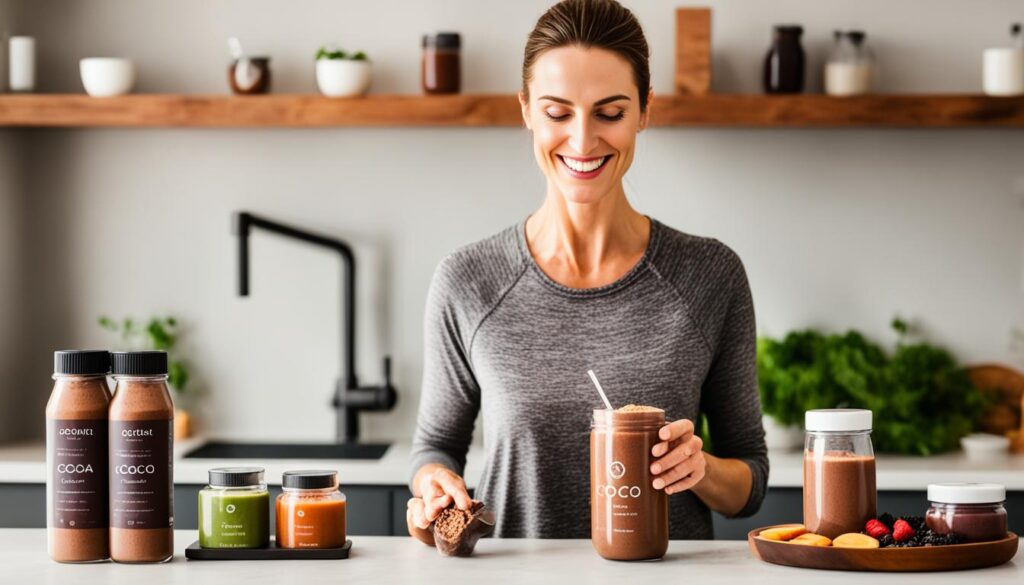
Cocoa can be easily incorporated into a healthy diet in various forms, allowing individuals to reap the benefits of its antioxidant properties. Two of the most common ways to enjoy the antioxidant-rich benefits of cocoa are through dark chocolate and cocoa powder.
Dark Chocolate and Cocoa Powder
Dark chocolate and unsweetened cocoa powder are excellent sources of incorporating cocoa into diet. Compared to milk chocolate, dark chocolate contains a higher percentage of cocoa, providing a more concentrated dose of antioxidant dark chocolate and cocoa powder. When selecting dark chocolate, opt for varieties with a cocoa content of at least 70% for maximum antioxidant benefits.
Cocoa powder is another versatile way to incorporate cocoa into diet. It can be added to smoothies, baked goods, hot beverages, and even savory dishes to boost the antioxidant profile of your meals and snacks. Look for high-quality, other cocoa-based products that are minimally processed to preserve the natural antioxidant compounds.
Other Cocoa-Based Products
In addition to dark chocolate and cocoa powder, there are various other cocoa-based products that can be incorporated into a healthy diet. Cocoa nibs, which are the crushed, roasted cocoa beans, provide a concentrated dose of antioxidants and can be sprinkled on top of yogurt, cereal, or used in baking.
Cocoa-based beverages, such as hot cocoa or cocoa-infused coffee, can also be a delightful way to incorporate cocoa into diet. When preparing these drinks, be mindful of added sugars and opt for unsweetened or minimally sweetened versions to maximize the antioxidant benefits.
By incorporating dark chocolate and cocoa powder, as well as other cocoa-based products into your diet, you can enjoy the rich flavor and potential health benefits associated with the antioxidant properties of cocoa.
Moderation is Key
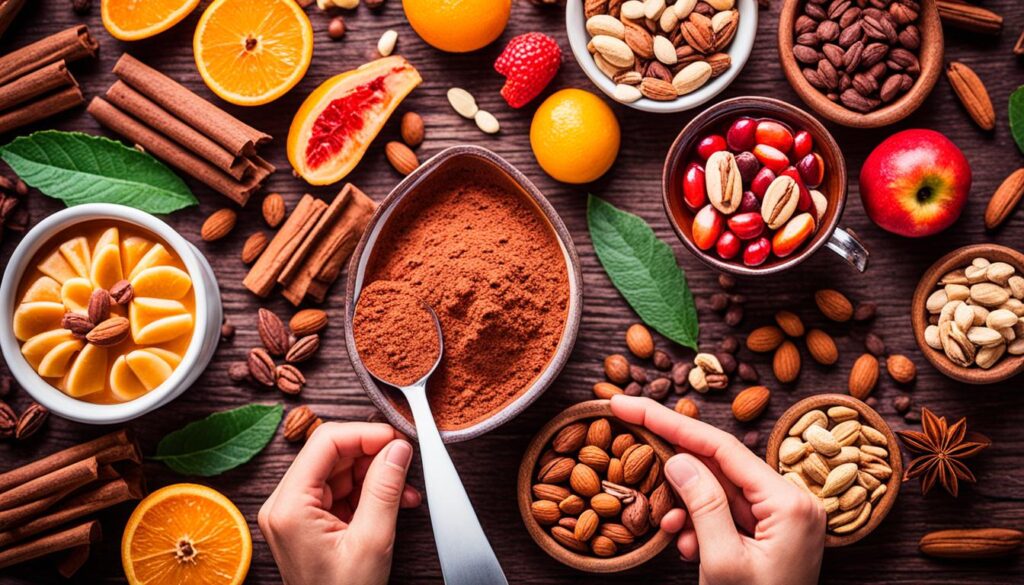
While the antioxidant properties of cocoa are undoubtedly beneficial, it’s important to consume it in moderation as part of an overall healthy diet. Cocoa and chocolate, particularly dark chocolate, can be high in calories, fat, and sugar, which may counteract some of the potential health benefits if consumed in excess.
Balancing Cocoa with a Healthy Diet
To maximize the benefits of cocoa’s antioxidants, it’s essential to integrate it into a balanced, healthy diet. Incorporating dark chocolate or cocoa powder in moderation, while focusing on a variety of nutrient-dense foods, can help you reap the rewards of cocoa’s antioxidant properties without compromising your overall health.
The recommended intake of cocoa to achieve potential health benefits varies, but research suggests that consuming around 45 grams of chocolate per week may lower the risk of cardiovascular disease by 11%. However, consuming more than 100 grams per week does not appear to provide additional health benefits.
| Nutritional Information | Value per 100g of Dark Chocolate (70-85% Cocoa) |
|---|---|
| Fiber | 11g |
| Iron | 66% of the Daily Value (DV) |
| Magnesium | 57% of the DV |
| Copper | 196% of the DV |
| Manganese | 85% of the DV |
By balancing cocoa with a healthy diet, you can enjoy the antioxidant benefits of cocoa while maintaining overall wellness. Moderation is the key to maximizing the positive impacts of this versatile ingredient.
Cocoa and Environmental Sustainability
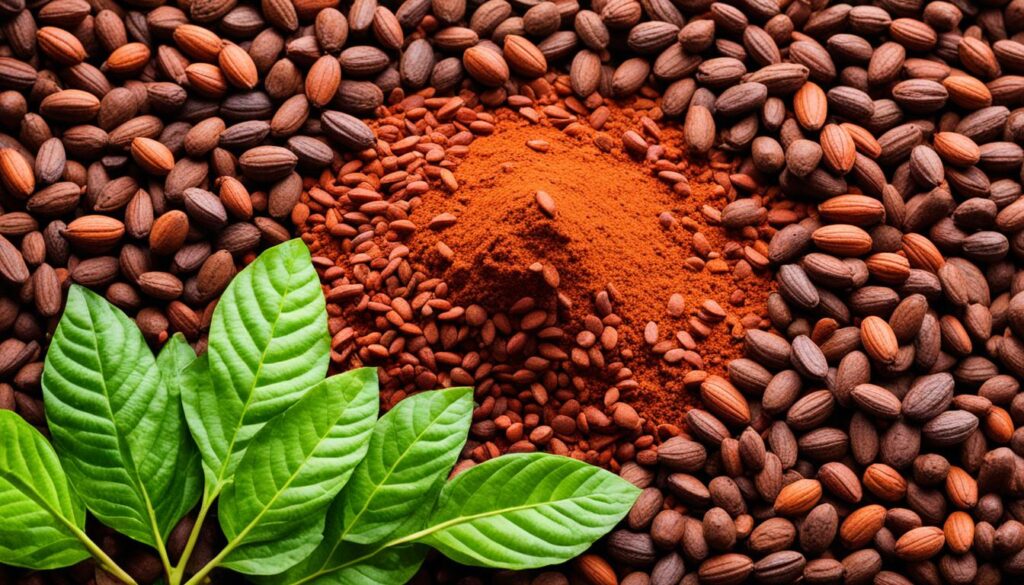
As the global demand for cocoa continues to rise, the environmental sustainability and ethical sourcing of this coveted ingredient have become increasingly important considerations. The environmental sustainability of cocoa production is a complex issue, with concerns ranging from deforestation and soil degradation to the working conditions of cocoa farmers, particularly in developing countries.
Ethical Sourcing
The ethical sourcing of cocoa is a crucial aspect of ensuring the sustainability of the industry. Many organizations and initiatives have emerged to promote sustainable cocoa production practices, such as fair trade certifications, sustainable farming techniques, and transparent supply chain management. These efforts aim to ensure that cocoa is produced in a way that balances profitability with environmental protection and social responsibility.
Sustainable cocoa production involves practices that minimize the impact on the environment, such as agroforestry systems that integrate cocoa cultivation with the preservation of native trees and biodiversity. Additionally, ethical sourcing initiatives work to improve the working conditions and livelihoods of cocoa farmers, promoting fair wages, safe working environments, and community development programs.
By supporting environmentally sustainable and ethically sourced cocoa, consumers can play a vital role in driving positive change in the industry and ensuring a more sustainable future for cocoa cultivation.
Research and Future Developments
The scientific community’s fascination with the antioxidant properties of cocoa continues to drive ongoing research and exploration of its potential health benefits. Numerous studies, such as a 2010 study on the effects of polyphenol-rich dark chocolate, have demonstrated the positive impact of cocoa on various health markers, including blood glucose levels, cholesterol, blood pressure, and inflammation.
Ongoing Studies
Researchers are delving deeper into the mechanisms by which cocoa’s flavanols and other polyphenolic compounds exert their antioxidant and anti-inflammatory effects. For instance, recent investigations have explored the role of cocoa in modulating cholesterol levels, as evidenced by studies showing altered plasma LDL and HDL concentrations in both normal and high-cholesterol individuals. Additionally, the potential benefits of cocoa flavanols on cardiovascular function, such as improved blood pressure responsiveness to exercise and enhanced vascular dilation, continue to be a focus of ongoing research.
Potential
As the scientific understanding of cocoa’s antioxidant properties deepens, the potential applications for its use in maintaining and promoting overall health are becoming increasingly evident. Ongoing studies are exploring the possibility of using cocoa-derived compounds as therapeutic agents for conditions like liver disease and cardiovascular disorders. Furthermore, the versatility of cocoa is reflected in the evolving consumer preferences, with a survey by Barry Callebaut USA, Inc. indicating a growing interest in exploring diverse chocolate varieties beyond the traditional milk chocolate. The future holds promise for continued innovation and exploration of cocoa’s antioxidant-rich potential, potentially leading to new dietary and supplementation strategies to support overall well-being.
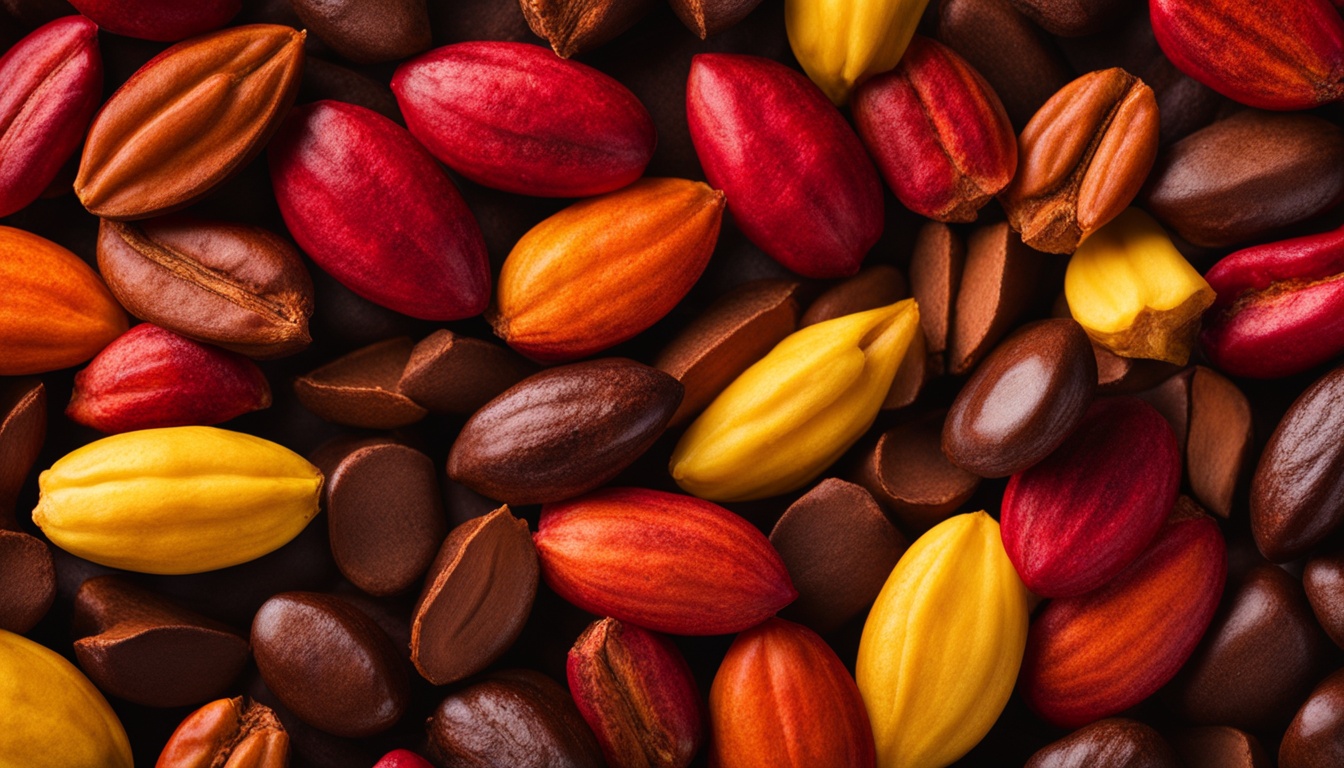
Leave a Reply